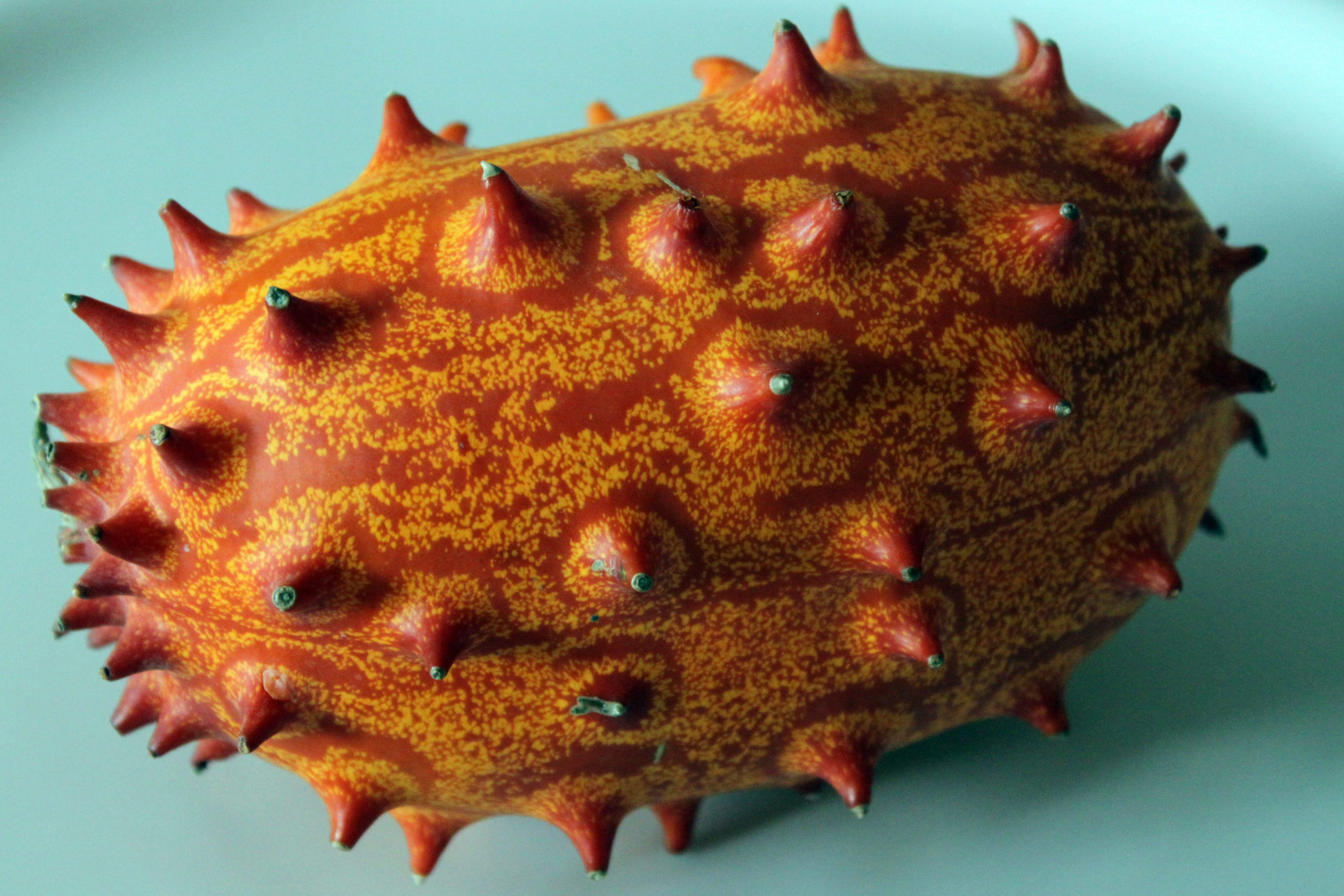Horned Melon
Cucumis metuliferus
Origin: Africa
Quick Facts
- grows well in Florida
- originated in the Kalahari Desert
- popular in New Zealand and California
- green when unripe and turn orange
- thorns can pierce the skin
- often sold as an ornamental
- can be stored for months

HEADING about something general
A SUBHEADING about something specific
Horned Melons, also known as “kiwanos” or “jelly melons” are fascinating plants originating from Southern Africa. They’ve made their way around the globe despite not being well-known by many. They have a citrus-like taste, with insides of a consistency similar to a pomegranate. They’re quite easy to grow in North and Central Florida as well, due to their preferred temperatures as well as the plentiful rainfall.
In Africa
The Horned Melon is interesting for a number of reasons, including its limited history. In Africa, it is known for being a rare source of water in the Kalahari Desert during the dry season[1], but little else is said.
The most well-known name for the fruit, “kiwano” does not actually originate from Africa, but from New Zealand, named by farmers hoping to sell the fruit[2].
In America
Horned melons were introduced to the US in the 1930s. While the plant is grown in California, it has yet to have a serious impact or large worldwide demand. Perhaps this is because some consider the taste is bland, or the amount of seeds, or how late it was introduced to the Americas
Nutrition Facts
Each individual Horned Melon is only estimated to contain about 92 calories.
The Horned Melon is a good source of Vitamins A, B6, and C. It also provides a large amount of iron and magnesium.
It’s not especially high in proteins or carbohydrates, but they are present, as one would expect in a plant.
Source of nutritional information
In Your Garden
These are best planted in well-drained areas with a lot of sun, and soil with a pH of 6-6.5. The temperature should remain above 57 degrees Fahrenheit. The plants should receive at least 1 inch of water a week
References for this section can be:
Recipes for Your Table
This section should provide a description of the plant as a culinary ingredient. This can include taste, flavor, common preparation techniques, names of several dishes, and other ingredients it is commonly associated with, etc.
Horned Melon Salad
4 chopped tomatoes, pulp of 1 melon, juice of 1 lime, 1 crushed garlic clove, 1 chopped red chili, ½ chopped red onion,1 stick of chopped celery, 1 large handful of chopped cilantro . Season with salt and pepper to taste
Be sure to cite the source of the recipe as a formatted reference if it came from print media. If you found it online, you should also include a link to the webpage.

References & Resources
- Ben-Erik Van Wyk (2000). People’s Plants: A guide to useful plants of southern Africa. South Africa: Briza Publications. p. 38.
-
https://whatscookingamerica.net/Q-A/KiwanoHornedMelon.htm
-
https://homeguides.sfgate.com/grow-kiwano-horned-melons-25732.html
-
https://enzedexotics.com/kiwano-recipes/kiwano-salsa-classic/ , also includes the picture on the “Growing and Eating” side.
- “Kiwano information – Exotic fruits | Its almost like a sour berry. Nature’s Pride”. www.naturespride.eu. Retrieved 2015-06-07.
- Welman, Mienkie. “Cucumis metuliferus”. PlantZAfrica.com. South African National Biodiversity Institute. Retrieved 7 June2015.
- ^“Living – Kiwano: It’s what’s inside that counts – Seattle Times Newspaper”. nwsource.com.
- Lim, T. K. (2012-01-30). Edible Medicinal And Non-Medicinal Plants: Volume 2, Fruits. Springer Science & Business Media. ISBN 9789400717633.
- “The Dinner Diva: Let’s discover some more little-known fruits”. DeseretNews.com. 21 February 2008.
- “Remembering ‘Kiwi Queen’ Frieda Caplan, Who Expanded U.S. Supermarket Offerings”. All Things Considered. NPR. January 27, 2020. Retrieved 28 January 2020.
- “Mountain Herb Estate – VEGETABLE – CUCUMBER, AFRICAN HORNED, Jelly Melon, Kiwano, Rooi-agurkie, Rooikomkommer (Afr.), Mokapana (Tswana) (Cucumis metuliferus)”. www.herbgarden.co.za. Retrieved 2015-06-07.
- Benzioni, Aliza. “Kiwano”. www.hort.purdue.edu. Purdue University. Retrieved 3 June 2015.
This page was authored by David Hollingsworth as part of HUM2420: African Humanities at Santa Fe College. This page was edited by Dr. Sarah Cervone in the Department of Humanities and Foreign Languages at Santa Fe College.
This page was created as part of a Florida Folk Life project in collaboration with Santa Fe College and the Matheson Historical Museum.
For more information visit www.thefloridafolklifeproject.org
